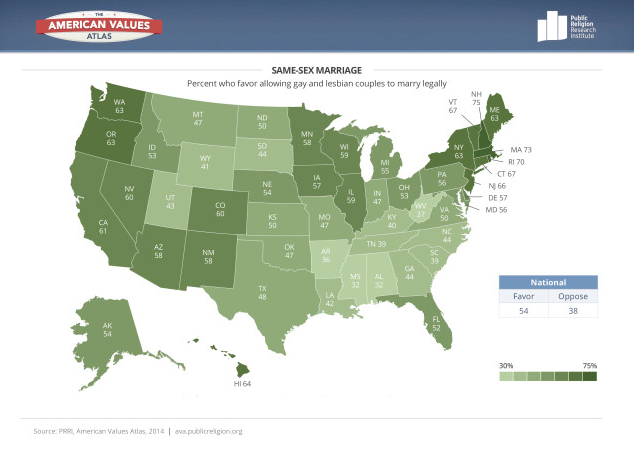Next week, the Supreme Court will hear oral arguments on Obergefell v. Hodges— along with three other related cases—concerning the legality of same-sex marriage under the Fourteenth Amendment. SCOTUS’s decision will take up the question of whether state bans against marriages involving same-sex partners violate these couples’ rights under the constitution, brought on by individual cases from Michigan, Ohio, Kentucky, and Tennessee.
In the years leading up to the national case, the issue of same-sex marriage has been decided at the state-level. New data from the American Values Atlas (AVA)provides an in-depth look at attitudes on this issue in each state. Currently, 29 states have a majority support, seven states have a plurality support, seven states have a majority opposition, and seven states have a plurality opposition for allowing gay and lesbian couples the right to marry legally.
The state most supportive of same-sex marriage is New Hampshire, with 75 percent of residents in favor, compared to 54 percent of Americans overall. Similar numbers are found within other northeastern states: Massachusetts (73 percent), Rhode Island (70 percent), Vermont (67 percent), and Connecticut (67 percent).
In contrast, Americans in the South are far less likely to support same-sex marriage. The least supportive states in the union—Mississippi and Alabama—voice high opposition with only 32 percent of residents in both states saying they favor allowing gays and lesbians to marry legally. Other southern states, such as Arkansas (36 percent), West Virginia (37 percent), Tennessee (39 percent), South Carolina (39 percent), and Kentucky (40 percent) show similarly disapproving numbers.
Western states also generally show majority support for same-sex marriage, with Washington (63 percent), Oregon (63 percent), and California (61 percent) residents showing high support for legalizing same-sex marriage, notable exceptions are Wyoming (41 percent), Utah (43 percent), and Montana (47 percent). These three states have a different religious make-up than their surrounding states, which may account for the dissimilarity.
Explore more of the AVA here and read our other reference guides on immigration reform and views of immigrants.
